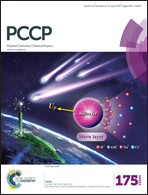The surface structure matters: thermal stability of phthalic acid anchored to atomically-defined cobalt oxide films
Abstract
We have investigated the influence of the structure of oxide surfaces on the thermal stability of anchored phthalic acid (PA) thin films. Specifically, we have performed temperature programmed infrared reflection absorption spectroscopy (TP-IRAS) of PA films deposited by physical vapor deposition (PVD) in ultra-high vacuum (UVH) onto three well-ordered surfaces: Co3O4(111), CoO(111) and CoO(100), all grown on Ir(100). Restructuring and desorption of PA were monitored in situ by TP-IRAS. Upon annealing of PA multilayers, co-adsorbed phthalic anhydride (PAA) desorbs at 200 K and a structural transition to a flat-lying adsorption geometry occurs at 250 K, before the PA multilayer desorbs at 300 K. At temperatures up to 400 K co-adsorbed mono-carboxylates partially desorb and partially convert to bis-carboxylates. Pronounced structure dependencies are observed regarding the thermal stability of the anchored bis-carboxylate monolayers. From Co3O4(111) the anchored PA desorbs over a wide range of temperatures centered at around 540 K. Weaker binding is observed for CoO(111) with desorption temperatures centered around 490 K. The strongest binding occurs on CoO(100), where the anchored PA films are found to be perfectly stable up to 510 K, before desorption starts and centers at around 580 K. The differences in binding strength are rationalized based on the density and the accessibility of the surface Co2+ ions. The findings show that the atomic structure of the oxide surface plays an important role in the stability of organic hybrid interfaces.


 Please wait while we load your content...
Please wait while we load your content...